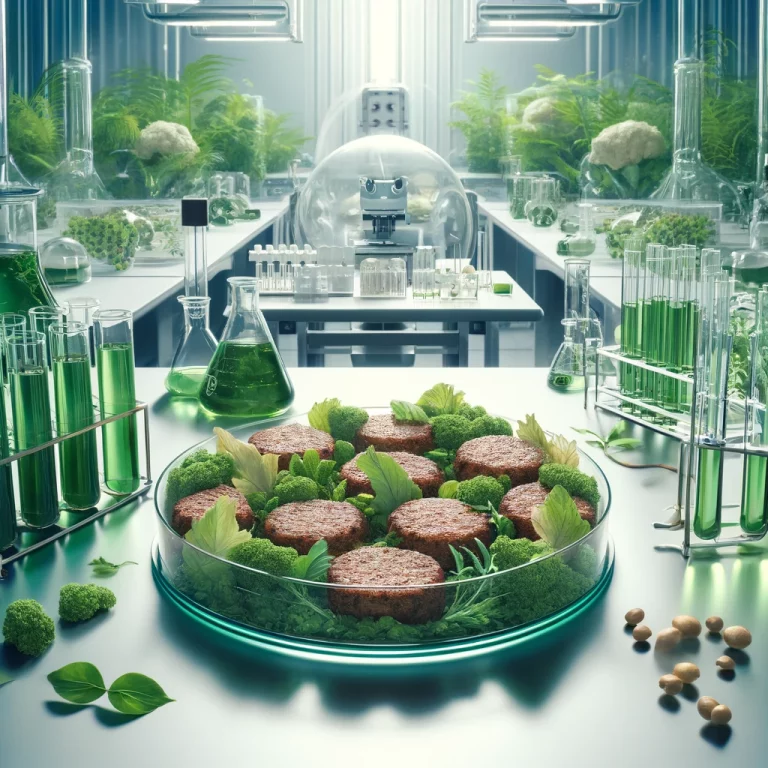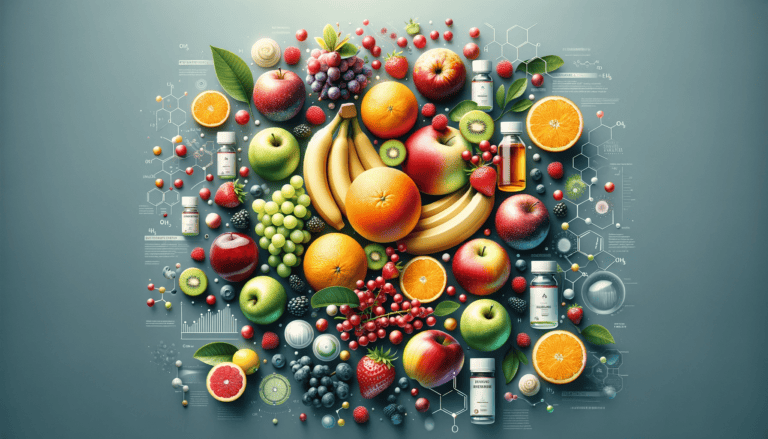Advancements in Industrial Biocatalysis
This paper examines biocatalysis’ critical role in green chemistry, focusing on its industrial applications, issues with enzyme stability and cost, and the bright future of enzyme engineering for sustainable chemical synthesis.

1. Introduction to Biocatalysis
Biocatalysis is a critical component of green chemistry, providing a sustainable method for accelerating chemical processes with enzymes and microorganisms. Enzymes, serving as biocatalysts, exhibit extraordinary specificity, efficiently driving reactions with excellent selectivity under mild circumstances (Silva and Pietrobom, 2016). This specificity is related to enzymes’ discrete active regions, which allow for selective interactions with specific substrates and exact reaction results (Rodrigues et al., 2013). Furthermore, immobilization of enzymes can improve their characteristics and efficiency when compared to free versions (Rodrigues et al., 2013).
The function of biocatalysis in organic synthesis highlights its importance in green chemistry, as it provides an environmentally benign option that coincides with the growing demand for sustainable practices. Biocatalysis has shown to be a flexible tool in a variety of industries, including pharmaceuticals, allowing for the manufacture of valuable molecules like as active pharmaceutical ingredients (APIs) using sustainable manufacturing procedures (Raynbird et al., 2020). The use of biocatalysis in such applications not only increases efficiency but also minimizes the environmental effect and energy consumption associated with typical chemical processes (Raynbird et al., 2020).
Furthermore, biocatalysis has various advantages over traditional chemical catalysts, including higher selectivity, greater sustainability, cheaper operating costs, and lesser toxicity (Espina et al., 2021). These benefits lead to cleaner production processes, lower environmental impact, and increased safety for operational people (Espina et al., 2021). Biocatalysis integration into industrial processes has become common practice, suggesting its maturity as a technique that contributes to the advancement of green chemistry (Gutiérrez et al., 2010).
Biocatalysis has emerged as an intelligent and sustainable method in chemical synthesis, offering great efficiency, specificity, and ecologically benign processes. Its application in a variety of industries highlights its importance in accelerating the transition to greener and more sustainable chemistry processes.
2. Applications of Biocatalysis in Industry
Biocatalysis is important in many industries, including medicines, chemicals, and food, as it provides long-term and efficient solutions for complex molecule synthesis, biofuel production, and food flavor enhancement. In the pharmaceutical sector, biocatalysis has become indispensable, allowing for the efficient and selective synthesis of chiral medicines and active pharmaceutical ingredients (APIs) (Adams et al., 2019). The capacity to tailor enzymes has broadened the use of biocatalysis in pharmaceutical manufacture, matching the needs of industrial processes (Truppo, 2017).
In the chemical industry, biocatalysis is especially useful for producing high-value carboxylic acids, including chiral versions, which are used in a variety of industries including food, materials, and medicines (Wu et al., 2020). The immobilization of enzymes has made tremendous progress, increasing their stability and reusability in industrial processes and thereby contributing to sustainable chemistry (Sheldon & Woodley, 2017). Furthermore, guided evolution of enzymes has enabled the development of biocatalysts that are more environmentally benign than traditional catalysts, helping industries ranging from bioremediation to pharmaceuticals (Porter et al., 2015).
Biocatalysis is important in the food sector since it improves flavors and textures while also providing a green and efficient method to food production (Federsel et al., 2021). Enzyme immobilization on a variety of substrates, including cellulose fibers and polymer nanoparticles, has resulted in reusable biocatalytic systems for cascade reactions, helping to develop sustainable food processing processes (Goldhahn et al., 2019; Tian et al., 2023). Biocatalysis is used in food production for a variety of purposes, including improving food preservation, emulsification, and overall quality.
Biocatalysis’s wide range of industrial applications highlight its importance in advancing sustainable practices and innovation in the pharmaceutical, chemical, and food sectors. Continuous advances in enzyme engineering, immobilization techniques, and process optimization are paving the road for biocatalysis to become a widely used tool in current industrial processes.
3. Challenges and Future Perspectives
Current issues in biocatalysis include enzyme stability, cost-effectiveness, and the requirement for broader substrate ranges. Enzyme stability is critical since enzymes are frequently exposed to temperature, pH, salt concentration, co-solvents, shear forces, and surface contacts, all of which can impact their activity and longevity in industrial processes (Bommarius & Paye 2013). Furthermore, the cost of enzyme manufacturing and purification remains a substantial barrier, limiting the scalability and commercial viability of biocatalytic processes (Goodwin et al. 2019). Furthermore, the limited substrate range of enzymes is a hurdle, demanding the development of innovative biocatalysts with broader substrate specificity in order to broaden the application of biocatalysis in varied chemical transformations (Colin et al., 2015).
Looking ahead, ongoing biocatalysis research aims to solve these problems by advances in enzyme engineering, immobilization techniques, and the identification of novel biocatalysts. Enzyme engineering is critical for improving enzyme stability, activity, and substrate specificity, allowing the creation of custom biocatalysts for specific industrial applications (Wu et al., 2020). Immobilization approaches, such as those employing metal-organic frameworks and carbon nanotubes, seek to improve enzyme operating stability and reusability while overcoming obstacles associated with enzyme leaching and structural perturbations (Neupane et al., 2019). Furthermore, the discovery of novel biocatalysts, such as enzymes from unknown microbial origins and metagenomic research, has the potential to yield enzymes with distinct catalytic characteristics and broader substrate ranges (Colin et al., 2015).
The future of biocatalysis includes the development of continuous-flow systems, microreactors, and Pickering emulsion catalysis to improve process efficiency and productivity (Fernandes & Carvalho, 2021; Wei et al., 2022; Ni et al., 2022). These technologies seek to enhance biocatalytic reactions, improve mass transfer, and allow for the seamless integration of biocatalysis into industrial processes. Furthermore, self-assembled polymeric nano- and microreactors, as well as polymer-induced biofilms, provide novel approaches to improving biocatalytic efficiency and stability (Wang et al., 2022; Adoni et al., 2022).
To summarize, while challenges remain in biocatalysis, ongoing research efforts in enzyme engineering, immobilization techniques, and the exploration of novel biocatalysts hold promise for overcoming these obstacles and moving the field forward toward more sustainable and efficient chemical synthesis processes.
References:
Adams, J., Brown, M., Díaz‐Rodríguez, A., Lloyd, R., & Roiban, G. (2019). Biocatalysis: a pharma perspective. Advanced Synthesis & Catalysis, 361(11), 2421-2432. https://doi.org/10.1002/adsc.201900424
Adoni, P., Romanyuk, A., Overton, T., & Fernández-Trillo, F. (2022). Polymer-induced biofilms for enhanced biocatalysis. Materials Horizons, 9(10), 2592-2602. https://doi.org/10.1039/d2mh00607c
Bommarius, A. and Paye, M. (2013). Stabilizing biocatalysts. Chemical Society Reviews, 42(15), 6534. https://doi.org/10.1039/c3cs60137d
Colin, P., Kintses, B., Gielen, F., Miton, C., Fischer, G., Mohamed, M., … & Hollfelder, F. (2015). Ultrahigh-throughput discovery of promiscuous enzymes by picodroplet functional metagenomics. Nature Communications, 6(1). https://doi.org/10.1038/ncomms10008
Espina, G., Atalah, J., & Blamey, J. (2021). Extremophilic oxidoreductases for the industry: five successful examples with promising projections. Frontiers in Bioengineering and Biotechnology, 9. https://doi.org/10.3389/fbioe.2021.710035
Federsel, H., Moody, T., & Taylor, S. (2021). Recent trends in enzyme immobilization—concepts for expanding the biocatalysis toolbox. Molecules, 26(9), 2822. https://doi.org/10.3390/molecules26092822
Fernandes, P. and Carvalho, C. (2021). Multi-enzyme systems in flow chemistry. Processes, 9(2), 225. https://doi.org/10.3390/pr9020225
Goldhahn, C., Burgert, I., & Chanana, M. (2019). Nanoparticle‐mediated enzyme immobilization on cellulose fibers: reusable biocatalytic systems for cascade reactions. Advanced Materials Interfaces, 6(19). https://doi.org/10.1002/admi.201900437
Goodwin, N., Morrison, J., Fuerst, D., & Hadi, T. (2019). Biocatalysis in medicinal chemistry: challenges to access and drivers for adoption. Acs Medicinal Chemistry Letters, 10(10), 1363-1366. https://doi.org/10.1021/acsmedchemlett.9b00410
Gutiérrez, M., Ferrer, M., Yuste, L., Rojo, F., & Monte, F. (2010). Bacteria incorporation in deep‐eutectic solvents through freeze‐drying. Angewandte Chemie, 49(12), 2158-2162. https://doi.org/10.1002/anie.200905212
Neupane, S., Patnode, K., Li, H., Baryeh, K., Liu, G., Hu, J., … & Yang, Z. (2019). Enhancing enzyme immobilization on carbon nanotubes via metal–organic frameworks for large-substrate biocatalysis. Acs Applied Materials & Interfaces, 11(12), 12133-12141. https://doi.org/10.1021/acsami.9b01077
Ni, L., Yu, C., Wei, Q., Liu, D., & Qiu, J. (2022). Pickering emulsion catalysis: interfacial chemistry, catalyst design, challenges, and perspectives. Angewandte Chemie, 61(30). https://doi.org/10.1002/anie.202115885
Porter, J., Rusli, R., & Ollis, D. (2015). Directed evolution of enzymes for industrial biocatalysis. Chembiochem, 17(3), 197-203. https://doi.org/10.1002/cbic.201500280
Pyser, J., Chakrabarty, S., Romero, E., & Narayan, A. (2021). State-of-the-art biocatalysis. Acs Central Science, 7(7), 1105-1116. https://doi.org/10.1021/acscentsci.1c00273
Rajulu, M., Thirunavukkarasu, N., Suryanarayanan, T., Ravishankar, J., Gueddari, N., & Moerschbacher, B. (2010). Chitinolytic enzymes from endophytic fungi. Fungal Diversity, 47(1), 43-53. https://doi.org/10.1007/s13225-010-0071-z
Raynbird, M., Sampson, J., Smith, D., Forsyth, S., Moseley, J., & Wells, A. (2020). Ketone reductase biocatalysis in the synthesis of chiral intermediates toward generic active pharmaceutical ingredients. Organic Process Research & Development, 24(6), 1131-1140. https://doi.org/10.1021/acs.oprd.0c00120
Rodrigues, R., Ortíz, C., Berenguer-Murcia, Á., Torres, R., & Fernández‐Lafuente, R. (2013). Modifying enzyme activity and selectivity by immobilization. Chemical Society Reviews, 42(15), 6290-6307. https://doi.org/10.1039/c2cs35231a
Sheldon, R. and Woodley, J. (2017). Role of biocatalysis in sustainable chemistry. Chemical Reviews, 118(2), 801-838. https://doi.org/10.1021/acs.chemrev.7b00203
Silva, M. and Pietrobom, D. (2016). Simplification of lipase design in the enzymatic kinetic resolution of amines by saturation transfer difference nmr. Journal of the Brazilian Chemical Society. https://doi.org/10.5935/0103-5053.20160077
Tian, Q., Zhang, J., Yan, J., Zhang, S., & Yu, Z. (2023). Enzyme anchoring amphiphilic polymer nanoparticles for enhanced pickering interfacial biocatalysis. Acs Applied Polymer Materials, 5(3), 1747-1755. https://doi.org/10.1021/acsapm.2c01868
Truppo, M. (2017). Biocatalysis in the pharmaceutical industry: the need for speed. Acs Medicinal Chemistry Letters, 8(5), 476-480. https://doi.org/10.1021/acsmedchemlett.7b00114
Wang, Y., Zhao, Q., Haag, R., & Wu, C. (2022). Biocatalytic synthesis using self‐assembled polymeric nano‐ and microreactors. Angewandte Chemie, 61(52). https://doi.org/10.1002/anie.202213974
Wei, W., Ettelaie, R., Zhang, X., Fan, M., Dong, Y., Li, Z., … & Yang, H. (2022). Co‐compartmentalization of enzymes and cofactors within pickering emulsion droplets for continuous‐flow catalysis. Angewandte Chemie, 61(45). https://doi.org/10.1002/anie.202211912



